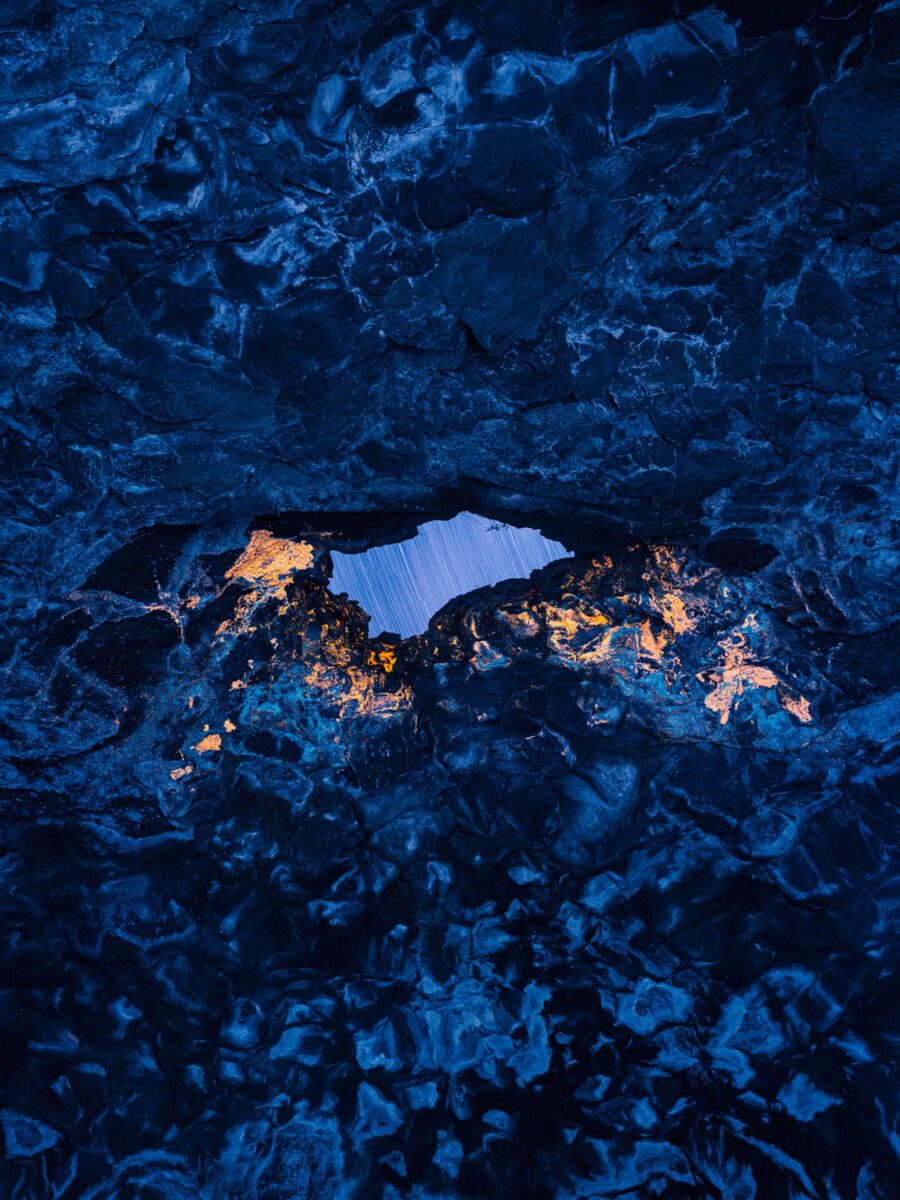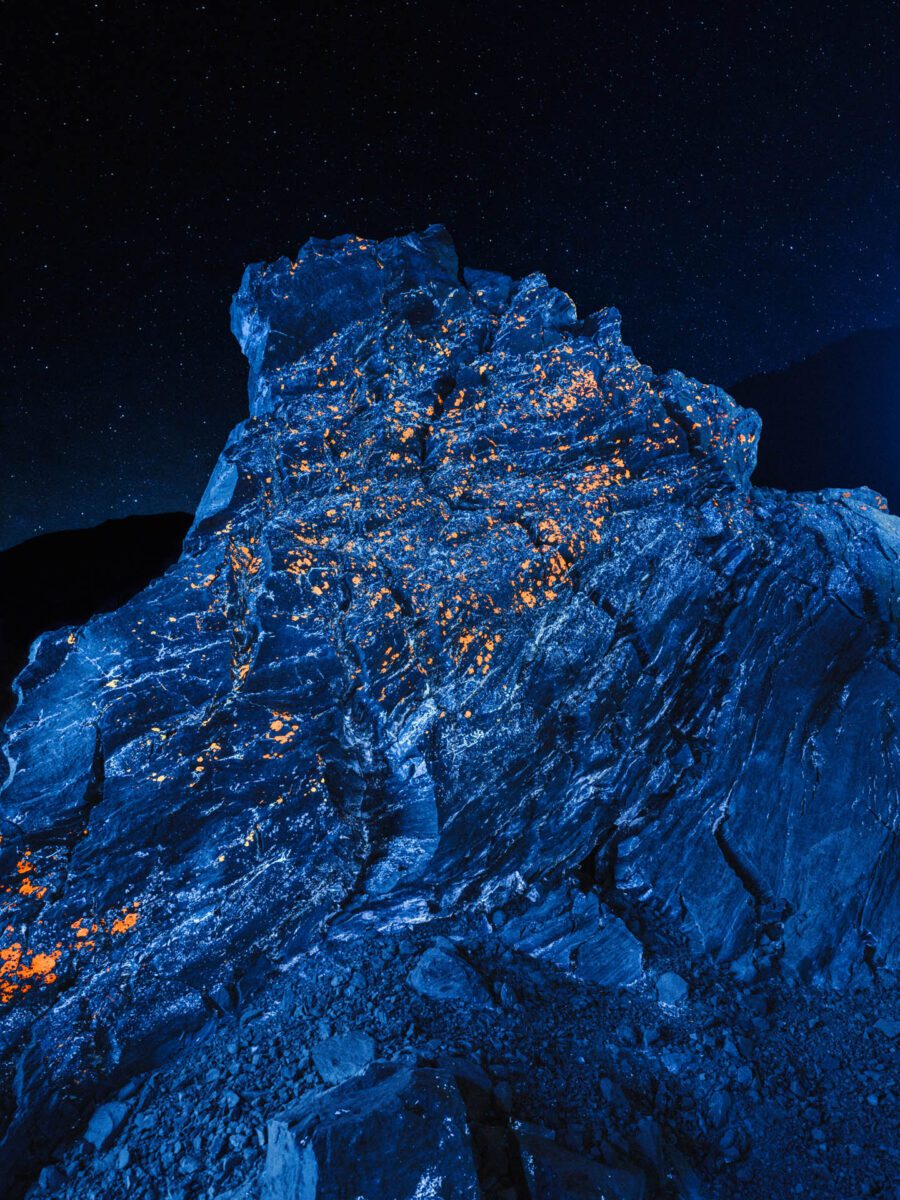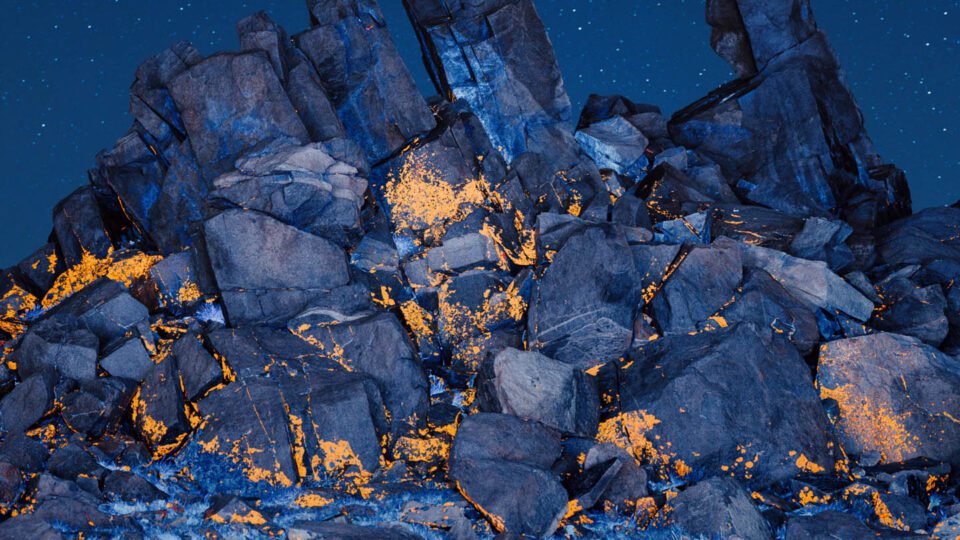When you hear the words “American West”, what do you imagine? A certain type of image has been firmly cemented in the cultural vernacular, and it is often replete with stereotypes: expansive prairies and plains; cowboys, ranches and saloons; abandoned mines and earth-toned colour palettes. All of this has culminated in a mythical sense of the “Wild West” – a lore fed to us by classic spaghetti western movies.
Cody Cobb (b. 1984) is a photographer and keen explorer known for atmospheric and contemplative landscapes. His work often focuses on this part of the world, but avoids the stereotypical grandeur or romanticised depictions associated with the region. The Spectral series, for example, offers an entirely different perspective. The images depart from conventional motifs; instead, his pictures glow with fiery orange and ice blues, zeroing in on details from areas where collapsed lava tubes can be found, or high up where lichens thrive. The body of work was made using long exposures and an ultraviolet light, showing us a spectrum that is usually invisible to the human eye. It’s refreshing to look at the Earth this way: to zoom in on textures and reveal concealed colours. Cobb demonstrates how even the most well-documented locations can be re-evaluated when observed from different angles.
This sentiment seems to be keenly felt by a new generation of photographers. There’s a sense of political engagement and a desire to use the camera to tell authentic stories or raise awareness about issues connected to the land. David Benjamin Sherry’s (b. 1981) American Monuments series, shot in hyperreal monochrome, was created in 2017 in response to sites that were being threatened by Trump’s administration. The images were taken as a form of photographic activism, with saturated colour palettes alerting viewers to a sense of danger – of human intervention stepping onto these iconic terrains – whilst preserving the natural beauty of the landscapes through the camera lens. Wendy Red Star (b. 1981), meanwhile, an Apsáalooke (Crow) artist, challenges the erasure of Indigenous perspectives in depictions of the West. She uses humour and vivid colours to critique colonial portrayals of Native Americans, as in her series Four Seasons. In recent years, Cobb has been recognised by leading awards like the Aesthetica Art Prize and Royal Photographic Society IPE 162, and featured by Apple, Google, Samsung and National Geographic. We sat down to discuss his process, and how he is pushing this classic genre in fresh directions.

A: How did you get started in photography? Where does your passion for the outdoors originate from?
CC: My interest in photography came along in an indirect way. It was around the turn of the millennium, when I was a teenager in rural Louisiana. I would spend time alone exploring abandoned buildings. Initially, I used my Canon Powershot A40 point-and-shoot digital camera as a tool to capture textures from those rusted and decaying ruins for digital collages. My fascination with digital art at an early age led to a career in motion design and visual effects work in Seattle, which introduced me to an entirely different realm. Coming from Louisiana, where I spent most of my time inside dark buildings, encountering the massive landscapes just outside of the city was transformative. Suddenly, I was surrounded by geology that seemed impossible: glaciers, rainforests, volcanic peaks. It was overwhelming, in the best way, and I felt compelled to try to capture not only the places themselves, but the experiences that had fundamentally shifted the way I observe my surroundings. That has been at the core of my practice ever since.
A: Is there are a particular location you love most?
CC: The American West has this incredible diversity that has kept me fixated for over a decade now. The Olympic Peninsula is a perfect example – you can experience rugged coastlines, rainforests, alpine meadows and glaciers all in one day. I’ve recently relocated to the southwest, between the Mojave and Great Basin, where the isolation feels more absolute. I’m also spending significant time in Taiwan each year, which presents this fascinating contrast in how landscape and human presence can coexist. It’s become one of my chosen places to explore and Taipei is easily my favourite city in the world.
A: What does a day on shoot look like? Do you go in with an idea of what you want the outcome to be?
CC: My process involves spending weeks alone, living out of my car or tent, allowing myself to become untethered from normal routines. After a few days of walking and observing, my perception of space shifts. My awareness seems to expand, and I start noticing subtleties that might otherwise pass unobserved. I don’t scout locations or plan shots. Instead, I try to remain receptive to those fleeting moments when light and land align in ways that feel both surprising and inevitable. Sometimes that means waiting hours for the right conditions, other times it means recognising when to put the camera away and simply experience a place.

A: Google searches for “American landscape photography” bring up names like Ansel Adams and Edward Weston. Twentieth century images are often critiqued for their overly romanticised and majestic views. Where do you feel your work sits within this narrative?
CC: The legacy of American landscape photography is complex, and I’m constantly questioning where my work fits within it. Whilst I’m fascinated by names like Adams, Weston and Watkins, I feel pulled in a different direction with my work. Instead of recording majestic vistas, I’m more interested in how these spaces affect us psychologically – or even spiritually. It’s my way of questioning our assumptions about these places, highlighting how much remains unknown even in well-photographed locations. I’m also increasingly focused on projects that document conservation efforts and environmental change, trying to move beyond pure aesthetics to engage with the urgent realities facing these landscapes. Indigenous voices are easily the most well-spoken when it comes to describing an integrated relationship with nature, which we’ve made separate from ourselves. That is deeper than anything I will ever experience. It needs to be communicated to those of us who are struggling to relate to the land in any way other than through recreation or exploitation.
A: Are there any contemporaries whom you look up to? CC: Alex Gaidouk will always be my favourite photographer. We both became interested in the medium at the same time and have continued to motivate each other for 20 years. His work focuses on a totally different subject matter – the city – in a way that inspires the way I frame the outdoors, and vice versa.

A: How did you achieve the colour effects in Spectral? CC: Spectral came from experimenting with ultravioletinduced visible fluorescence using a light I found for sale online. I discovered that certain minerals and organic material emit an otherworldly glow when exposed to UV light at night. Because of the low levels of ambient light needed for this, I’m way out there at odd hours, often sleep-deprived, making long exposures while shining a light at rocks. The seemingly alien colours aren’t created in post-production – it’s a natural phenomenon that’s otherwise invisible to us.
A: Has your creative approach evolved over the years?
CC: My work has seemed to oscillate from straight landscape photography towards something more experimental, and back again. The longer I spend in these places, the more interested I’ve become in exploring psychological states rather than just physical locations. Over the years, I’ve introduced artificial lighting to describe what being a small human alone in large places at night feels like. I think my background in design continues to influence how I approach composition and colour.

A: You collaborate with major brands and publications. What is that like? How does the dynamic work?
CC: Working with publications and brands has been incredible and the ones that I’m most excited about are the collaborations that align with my personal practice. The Samsung Frame TV, for instance, has allowed my work to reach people in a completely different way: as a television that doubles as a piece of art when not in use. It’s such a novel platform for artists and it has allowed my images to live in homes around the world. Whilst I will always love seeing large prints of mine on a wall, I’m grateful that this technology has made my work more accessible. Some of my favourite editorial assignments for WIRED and The New York Times have given me the opportunity to spend a day in the field with environmentalists and scientists who have a profound understanding of the places that I love.
A: What are you up to right now? Where are you based, and do you have any plans for the future?
CC: I’m based just outside of Las Vegas which gives me easier access to the xeric, alien landscapes I’ve been most drawn to lately. I’m continuing to work on my ongoing series simultaneously, whilst also inventing and developing new projects as I go. My latest experimental series revolves around using light to record surface information from objects in the landscape that can then be 3D printed in bas relief. I’m really interested in pushing the boundaries of how we perceive landscapes. I’ve been playing with developing ways to translate these two-dimensional images into something more tactile using 3D printing and laser etching into glass. More importantly, I want to continue to develop a way of better communicating the urgency of protecting these places, whilst maintaining that sense of mystery that drew me to them in the first place. It’s an ongoing process that continues to both elude and inspire me.
Words: Frances Johnson
Image credits:
1. Cody Cobb, from Spectral, (2021). Geological formations lit by UV light in the White Mountains of California.
2. Cody Cobb, from Spectral (2021). Grasses and lichens fluoresce at nearly 12,000 ft above sea level in the rugged and exposed White Mountains of California.
3. Cody Cobb, from Spectral, (2021). Looking at the night sky through a collapsed lava tube in New Mexico.
4. Cody Cobb, from Spectral, (2021). An enormous, glacial erratic boulder composed of quartz monzonite and decorated with lichen sits along the eastern foothills of the Sierra Nevada range in California.
5. Cody Cobb, from Spectral, (2022). Pillar of obsidian lit with UV light in California’s Owens Valley.





